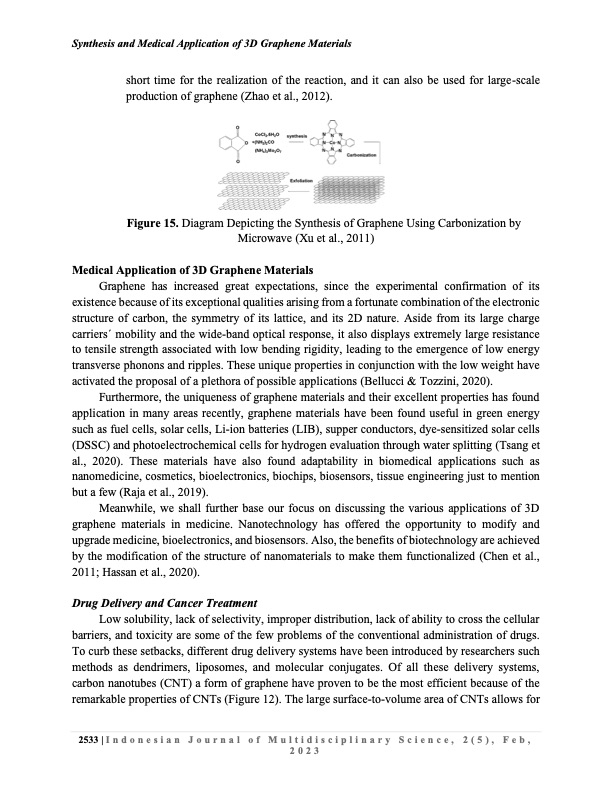
PDF Publication Title:
Text from PDF Page: 014
Synthesis and Medical Application of 3D Graphene Materials short time for the realization of the reaction, and it can also be used for large-scale production of graphene (Zhao et al., 2012). Figure 15. Diagram Depicting the Synthesis of Graphene Using Carbonization by Microwave (Xu et al., 2011) Medical Application of 3D Graphene Materials Graphene has increased great expectations, since the experimental confirmation of its existence because of its exceptional qualities arising from a fortunate combination of the electronic structure of carbon, the symmetry of its lattice, and its 2D nature. Aside from its large charge carriers ́ mobility and the wide-band optical response, it also displays extremely large resistance to tensile strength associated with low bending rigidity, leading to the emergence of low energy transverse phonons and ripples. These unique properties in conjunction with the low weight have activated the proposal of a plethora of possible applications (Bellucci & Tozzini, 2020). Furthermore, the uniqueness of graphene materials and their excellent properties has found application in many areas recently, graphene materials have been found useful in green energy such as fuel cells, solar cells, Li-ion batteries (LIB), supper conductors, dye-sensitized solar cells (DSSC) and photoelectrochemical cells for hydrogen evaluation through water splitting (Tsang et al., 2020). These materials have also found adaptability in biomedical applications such as nanomedicine, cosmetics, bioelectronics, biochips, biosensors, tissue engineering just to mention but a few (Raja et al., 2019). Meanwhile, we shall further base our focus on discussing the various applications of 3D graphene materials in medicine. Nanotechnology has offered the opportunity to modify and upgrade medicine, bioelectronics, and biosensors. Also, the benefits of biotechnology are achieved by the modification of the structure of nanomaterials to make them functionalized (Chen et al., 2011; Hassan et al., 2020). Drug Delivery and Cancer Treatment Low solubility, lack of selectivity, improper distribution, lack of ability to cross the cellular barriers, and toxicity are some of the few problems of the conventional administration of drugs. To curb these setbacks, different drug delivery systems have been introduced by researchers such methods as dendrimers, liposomes, and molecular conjugates. Of all these delivery systems, carbon nanotubes (CNT) a form of graphene have proven to be the most efficient because of the remarkable properties of CNTs (Figure 12). The large surface-to-volume area of CNTs allows for 2533|Indonesian Journal of Multidisciplinary Science, 2(5), Feb, 2023PDF Image | Medical Application of 3D Graphene

PDF Search Title:
Medical Application of 3D GrapheneOriginal File Name Searched:
SYNTHESIS-MEDICAL-APP-3D-GRAPHENE.pdfDIY PDF Search: Google It | Yahoo | Bing
Salgenx Redox Flow Battery Technology: Power up your energy storage game with Salgenx Salt Water Battery. With its advanced technology, the flow battery provides reliable, scalable, and sustainable energy storage for utility-scale projects. Upgrade to a Salgenx flow battery today and take control of your energy future.
| CONTACT TEL: 608-238-6001 Email: greg@infinityturbine.com | RSS | AMP |